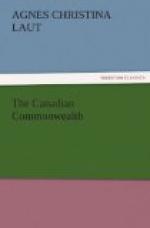In spite of the cry of the end of fur, more furs are marketed in the world than ever before in the history of the race—forty million dollars’ worth; twenty millions of which are handled in New York and Chicago and St. Louis and St. Paul; some five millions passing through Edmonton and Winnipeg and Montreal and Quebec; three millions for home consumption, two millions plus for export. Some years ago I went through all the Minutes of the Hudson’s Bay Company in London from 1670 to 1824 and have transcripts of those Minutes now in my library. In not a single year did the fur record exceed half a million dollars’ worth. Compare that to the American traffic to-day of twenty millions, or to the three and four hundred thousand dollar cargoes that each of the Hudson’s Bay Company and Revillons’ ships bears to Europe from Canada yearly.
“How much can a good Indian hunter make in a season?” I asked a fur-trader of the Northwest, because in nearly all accounts written about furs, you read a wail of reproach at milady for wearing furs when trapping entails such hardship and poverty on the part of the hunter.
“A good hunter easily earns six hundred dollars or seven hundred dollars a winter if he will go out and not hang around the minute he gets a little ahead. It takes from three thousand dollars to four thousand dollars to outfit a small free-trader to go up North on his own account. This stock he will turn over three or four times at a profit of one hundred per cent. on the supplies. For example, ten dollars cash will buy a good black otter up North. In trade, it will cost from twelve dollars to fifteen dollars. On the articles of trade, the profit will be fifty per cent. The otter will sell down at Edmonton for from twenty dollars to thirty dollars. It’s the same of muskrat. At the beginning of the season when the kits are plentiful and small, the trader pays nine cents for them up North. Down at the fur market he will get from twenty-five to sixty cents for them, according to size. There were one hundred and thirty-two thousand muskrat came to one firm of traders alone in Edmonton one year, which they will sell at an advance of fifty per cent.”
“How much fur comes yearly to Edmonton?” I asked an Edmonton trader. If you look at the map you will see that Edmonton is the jumping off place to three of the greatest fur fields of North America—down MacKenzie River to the Arctic, up Peace River to the mountain hinterland between the Columbia and the Yukon, east through Athabasca Lake to the wild barren land inland from Churchill and Hudson Bay.
“Well, we can easily calculate that. I know about how much is brought in to each of the traders there.”
I took pencil while he gave me the names. It totaled up to six hundred thousand dollars’ worth for 1908. When you consider that in its palmiest old days of exclusive monopoly the Hudson’s Bay Company never sold more than half a million dollars’ worth of furs a year, this total for Edmonton alone does not sound like a scarcity of furs.




